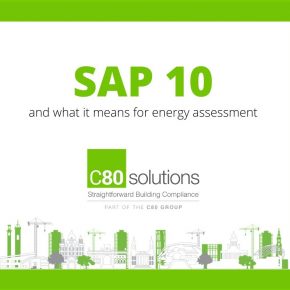
Back on the radar: SAP 10 and what it means for energy assessment
 New energy assessment methodology is on the horizon. Harry Hinchliffe, Energy Consultant and BREEAM Assessor at C80 Solutions, outlines the changes and their impact on design.
New energy assessment methodology is on the horizon. Harry Hinchliffe, Energy Consultant and BREEAM Assessor at C80 Solutions, outlines the changes and their impact on design.
“Like every other industry, construction has been preoccupied with unprecedented circumstances over the past year. As we still come to terms with the impact of COVID-19, it’s easy to overlook other issues which were on the sector’s radar before the pandemic hit. One such issue is an expected (and many say overdue) overhaul of the Standard Assessment Procedure (SAP) for assessing dwellings for their energy efficiency credentials, with SAP 10 replacing the increasingly outdated SAP 2012 methodology.
Current estimates expect SAP 10 to come into play in June 2022. The official arrival could be delayed, but it’s also entirely possible that it could be brought forward.
The most significant change is a reduction in electricity’s CO2 emission factor, decreasing from 0.519 kgCO2/kWh to 0.233 kgCO2/kWh, reflecting a much greener national grid which increasingly benefits from renewable energy technologies.
SAP 10: Achieving compliance
This will make it easier to achieve compliance with electric heating. With plans also in place to prohibit gas boilers in new build homes by 2025, many developers are likely to turn to heat pumps, electric panel heaters and electric underfloor heating as their primary heat sources. There could also be an increase in the use of electric boilers with an indirect cylinder for hot water.
Electricity generated by photovoltaic (PV) panels is factored into SAP 2012’s calculations for a flat even when there is no direct connection to the property, causing a misrepresentation in the many apartment buildings where only one connection exists, to a landlord’s supply. SAP 10’s formula only factors in PV supply if the apartment is directly connected, with clear implications for developments that need to meet carbon reduction requirements as a planning condition.
SAP 2012’s representation of energy use in domestic properties is based on different standard heating patterns for weekdays and weekends, but further studies demonstrate that this distinction does not necessarily bear out in real life.
The probability of any difference is even less likely now that working from home has become much more widespread. In contrast, SAP 10 applies the same standard heating pattern for every day of the week.
It will also introduce a more precise estimate of hot water demand, accounting for the number of showers and baths as well as shower types and flow rates (for example, electricity use from instantaneous electric showers will now form part of assessments).
Lighting is another factor that will see a significant overhaul. Under SAP 2012 the lighting assessment is extremely basic, only accounting for the number of low energy fittings being installed, but SAP10 will recognise the use of new lighting types which provide higher efficiency.
The assessment of fixed lighting design will involve a level of detail more in line with the non-domestic methodology known as SBEM.
SAP 10 calculations
Its calculation of lighting energy use will be based on the quantity and efficiency of the fixed lighting whilst taking into account the contribution of natural light, bringing window design into the assessment mix.
This will make it important to know more detail at the design stage regarding the specification of windows and lighting. SAP 10 will calculate a ‘reference lighting capacity’ based on the property’s floor area and solar gains.
If the lighting design falls outside of this reference lighting range (either above or below), the predicted lighting energy will be increased to account for ‘poor’ lighting or ‘surplus’ lighting.
SAP 10 will remove SAP 2012’s indicative options of low, medium and high to assess Thermal Mass Parameter (TMP) and instead will include a detailed calculation of a building’s actual TMP based on build material, construction, and kappa values which are referenced in BS EN ISO 13786.
SAP 10 will also change the way designers address the risk of overheating, reducing the amount of ventilation that they can assume is being gained from open windows, with factors such as outside noise and security taken into consideration. As a result, designers will be encouraged to reduce heat gains in other areas.
In SAP 10’s thermal bridging provisions, the Accredited Construction Details (ACD) scheme used under SAP 2012 is no longer considered to be sufficiently accurate.
Assessment will be based on other established sets of construction details, prompting a re-think of many design practices and encouraging more junction details to enable accurate calculation of psi values.
Where no details of thermal bridging are provided, the default y-value used in assessments has been raised from 0.15 w/m2k to 0.2 w/m2k, entailing a stiffer penalty for developers who fail to consider heat loss through building junctions.
C80 Solutions’ examinations
As a building consultancy with specialists in energy assessments, C80 Solutions has examined the proposed changes of SAP 10 and we consider them a welcome addition to the calculation methodology, more accurately representing how buildings perform.
Its role in encouraging more precision and detail in energy assessment will prove to be a very positive influence across residential construction.
As the energy grid continues to become greener, SAP 10 gives developers the opportunity to be more flexible in their design whilst still working towards the government’s carbon reduction targets.
Although SAP 10’s details were published some time ago, getting to grips with the implications dropped down the list of priorities in the wake of the pandemic. As we tentatively approach a return to normality, SAP 10 is likely to return to the forefront of the industry’s thoughts. The need to understand and embrace its principles is now a much more pressing matter.”
Latest news

26th July 2024
Enfield Speciality Doors completes world-class project for Atlas Copco HQ
A rundown office and warehouse building completely transformed into a modern headquarters for Atlas Copco has been fitted with more than 120 internal fire doors from Enfield Speciality Doors.
Posted in Access Control & Door Entry Systems, Articles, Building Industry News, Building Products & Structures, Building Systems, Case Studies, Doors, Interior Design & Construction, Interiors, Posts, Restoration & Refurbishment, Retrofit & Renovation, Security and Fire Protection, Sustainability & Energy Efficiency, Timber Buildings and Timber Products, Wooden products
26th July 2024
Abloy UK launches new white paper
Abloy UK, a leading provider of security and access control solutions, has launched a new white paper.
Posted in Access Control & Door Entry Systems, Architectural Ironmongery, Articles, Building Industry News, Building Products & Structures, Building Services, Doors, Facility Management & Building Services, Health & Safety, Information Technology, Innovations & New Products, Publications, Research & Materials Testing, Security and Fire Protection
26th July 2024
MCRMA Member Profile: David Roy, Director of Roofconsult
David Roy of MCRMA member company Roofconsult has more than 50 years’ experience to draw upon working in the building envelope sector and a unique perspective on how it has changed in that time.
Posted in Articles, BIM, Infrastructure & CAD Software, Building Associations & Institutes, Building Industry News, Building Products & Structures, Building Services, Building Systems, Cladding, Information Technology, Restoration & Refurbishment, Retrofit & Renovation, Roofs, Walls
26th July 2024
Strand: Enhancing Door Functionality and Safety
Craig Fox, Sales Director for Strand Hardware, outlines how door industry professionals might apply door limiting stays…
Posted in Architectural Ironmongery, Articles, Building Industry News, Building Products & Structures, Building Services, Doors, Facility Management & Building Services, Health & Safety, Restoration & Refurbishment, Retrofit & Renovation
 Sign up:
Sign up: